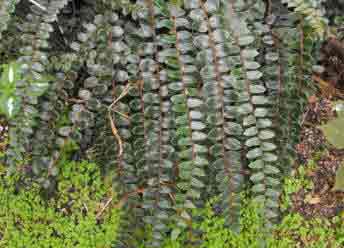Pellaea rotundifolia - The Button Fern

Pellaea rotundifolia - The Button Fern
A fern originating in dry climates such as are found in southern
Africa, South America, and parts of New Zealand. The Button fern
has a prostrate growth habit, with small, round, leathery
leaflets borne on short arching stems. With age the leaflets
elongate to a more oval-shape.
Its normal habitat is at the edges of desert or scrub land growing in the soil. This means that it is a perfect house plant for those who forget to water their plants or who are apt to be absent for lengthy periods. This is not to say that the fern needs no water whatever, but rather a fern that will tend to succumb to too much watering rather than too little watering.
Pellaea viridis is another form, maintaining a more traditional fern-shape with longer fronds of pointed leaflets.
Its needs: The Pellaeas will tolerate semi-shade, in draught-free
corners. Avoid direct sun. Gravel or pine bark should be added to the
potting mix to encourage free-drainage.
Pellaea rotundifiolia - The Button Fern can also be grown outside in milder areas and is frost hardy - just - but not one for being permanently frozen through the winter. It also makes for a container plant with a difference. The cascading foliage can be quite spectacular with the small round leaflets - not unlike a string of buttons!
Care of the Button Fern
The Button Fern is evergreen and likes to be kept moist through the winter, but not water-logged. Use a Foliage Houseplant fertiliser fertiliser once a month through the growing season , but cut the recommended dose to half strength. Increase humidity by misting the plants in summer.
It prefers a sunny position - even to the extend of mid day sun if grown outdoors. But if grown as a houseplant - avoid full sun through a window.
Good for: A very different foliage plant plant, the Button
fern does look good when planted in a hanging basket or a
shallow container.
Problems with the Button Fern
Trouble free generally with no pests or disease considered a problem. It can look a bit unkempt after a few seasons - easily remedied by cutting out the the straggly leaves back to the base of the plant in spring. New shoots will soon emerge.
Propagation of Button Fern
The accepted way for growers and fern enthusiasts is be sowing the spores on a damp organic based compost.
However, the fern can also be carefully divided in spring as active growth starts, with the divisions potted up separately. If basal growth is visible, then cut back the older fronds.
Comprehensive Guide to Propagating a Button Fern
Button Fern (Pellaea rotundifolia) is a charming, easy-care fern with round, button-like leaflets. Here's how to propagate it.
Sowing Spores- Collecting Spores: Mature Button Ferns produce spores on the undersides of their fronds. When these turn brown, carefully cut off the frond and place it spore-side down on a piece of paper. After a few days, the spores will fall off onto the paper.
- Preparing Compost: Fill a shallow container with damp organic-based compost. Sterilize the compost beforehand by baking it in the oven at 200°F (93°C) for half an hour to kill any fungi or pests.
- Sowing Spores: Sprinkle the collected spores evenly over the surface of the compost.
- Creating Ideal Conditions: Cover the container with a clear plastic bag to create a humid environment and place it in a location with bright, indirect light. The ideal temperature for germination is around 70°F (21°C).
- Germination: After several weeks, tiny prothalli (fern gametophytes) will appear. These will eventually develop into ferns.
- When to Divide: The best time to divide a Button Fern is in spring as active growth starts.
- How to Divide: Carefully remove the fern from its pot and gently separate the root ball into sections, each with a portion of roots and fronds.
- Potting Up Divisions: Plant each division in a pot filled with a mix of equal parts peat moss and perlite. Water thoroughly.
If new, basal growth is visible, this is a sign that your fern is healthy and growing well. You can cut back older, brown fronds at the base to improve the plant's appearance and make room for new growth.
Essential Tips for Successful Propagation- Water: Whether you're growing from spores or divisions, keep the compost consistently moist but not soggy.
- Humidity: Button Ferns love humidity. A pebble tray filled with water placed under the pot can help increase humidity.
- Light: Provide bright, indirect light. Too much direct sunlight can scorch the leaves.
- Fertilization: Feed monthly during the growing season with a balanced, water-soluble fertilizer diluted to half strength.
With patience and care, you can successfully propagate and enjoy the beauty of Button Ferns in your home!
Best Selling Gardening Products
Popular Gardening Sections

Problems
Identify Weeds in The Garden - How to deal with weeds. Diseases and Pest which harm your garden and plants, learn how to prevent, deter and erradicate your garden problems.
Garden Problems
Pruning
Pruning Guide. Shrubs flower better with correct pruning. Many illustrations and examples of what to do - and when. Includes evergreens, roses, flowering shrubs, spring flowering shrubs and pruning for stem effect. This is our most viewed and comprehensive section,
Pruning
Gardening Businesses
Gardening Businesses listed in the UK counties and USA states. County and State Listings of businesses involved in Garden supplies and services. If you wish to be added to the Directory, please send us your information. Having problems, use the search box
Businesses
Gardening
In this section you will learn about Gardening Basics, Containers, Landscaping, Propagation and Soil.
Gardening
Gardening Gifts
Gardening Gifts and Reviews, Read Before you Buy
- Gardening Gifts Ideas
- Gifts For Her
- Gifts For Men
- Power Tool Gifts
- Cheap Gifts
- Personalised Gifts
- Wildlife Gifts
- Family Gifts



